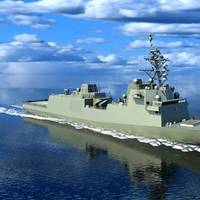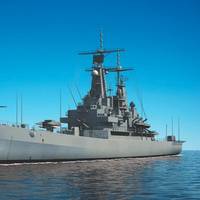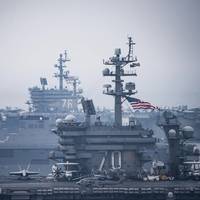U.S. Navy: Constellation-class Brings Frigates Back to the U.S. Fleet

Introducing a new class of warship can be fraught with pain, and the first ship is always the hardest – almost always behind schedule and over budget. And trying something new and transformational is even harder.The U.S. Navy knows this from experience. That’s one reason why the Navy is opting for a lower risk design for its next class of guided missile frigates (FFGs).Just about every new class has experienced a rough start. Although the USS Arleigh Burke-class of guided missile destroyers (DDGs) today represent the largest and most successful class of warships…
DCA to U.S. House: Fully Utilize HMT Fund

The U.S. House of Representatives is set to consider H.R. 2440, Full Utilization of the Harbor Maintenance Trust Fund bill on Monday October 28, 2019. The bill may be presented in the House under “suspension of the rules.”“We strongly support the Full Utilization of the Harbor Maintenance Trust Fund for intended purpose,” said William P. Doyle, CEO and Executive Director of the Dredging Contractors of America (DCA). “This bipartisan bill makes it easier for Congress to appropriate any funds collected in the Trust Fund for authorized harbor maintenance needs…
A Sea Change for Shipbuilding

When it comes to shipbuilding, the numbers are staggering: hundreds of millions of parts in one aircraft carrier. Billions of dollars proposed for Naval fleet development in the latest NDAA. Hundreds of thousands of private sector jobs in the U.S. alone. A 2015 MARAD report, for example, pegged the total economic impact associate with the industry at 400,000 jobs, $25 billion in labor income, and 37 billion in GDP (based on data from 2013). When the financing, jobs, technological developments and supply chain trade dedicated to shipbuilding around the world are added in…
US Navy: Bigger is Better, but at What Cost?

The U.S. Navy has a balanced fleet, but it wants to grow bigger and better. Will the budget allow both? Maritime Reporter's March 2017 cover story on the U.S. Navy was all about the numbers. There exists several plans to grow the fleet beyond the current number of 308 ships, the Mitre recommendation of 414 ships, the Center for Strategic and Budgetary Assessment 340-ship proposal, and the Navy’s decision to grow the fleet to 355 ships, and the Trump administration’s 350. With so many numbers being bandied about, there are even more suggestions on how to get there.
Skilled Workers Needed to Build Trump's Navy Vision
U.S. President Donald Trump says he wants to build dozens of new warships in one of the biggest peace-time expansions of the U.S. Navy. But interviews with ship-builders, unions and a review of public and internal documents show major obstacles to that plan. The initiative could cost nearly $700 billion in government funding, take 30 years to complete and require hiring tens of thousands of skilled shipyard workers - many of whom don't exist yet because they still need to be hired and trained, according to the interviews and the documents reviewed. Trump has vowed a huge build-up of the U.S. military to project American power in the face of an emboldened China and Russia. That includes expanding the Navy to 350 warships from 275 today.
Trump Seeks 'Historic' Increase in Defense Spending

President Donald Trump is seeking what he called a "historic" increase in military spending of more than 9 percent, a huge rise even as the United States has wound down major wars in Iraq and Afghanistan and remains the world's strongest military power. Trump will seek to boost Pentagon spending in the next fiscal year by $54 billion in his first budget proposal and slash the same amount from non-defense spending, including a large reduction in foreign aid, a White House budget official said on Monday. The president does not have the final say on federal spending.
Op/Ed: Fix the HMTF Now … or in 2027

The Harbor Maintenance Trust Fund (HMTF) has been misused and underutilized for years, leaving U.S. ports and harbors in subpar conditions and disadvantaging the very shippers that pay to modernize and maintain them – to the tune of nearly $2 billion per year. In May, the U.S. House of Representatives’ (House) Committee on Transportation and Infrastructure (Committee) took a major step in the right direction by passing the Water Resources Development Act of 2016, which among other things…
Allowing US Oil Export Could Push Crude Prices Higher -CBO
Lifting the ban on U.S. crude exports could push the price of domestic oil up roughly $2.50 a barrel in the coming decade, a report from the Congressional Budget Office said on Wednesday. "CBO estimates that authorizing exports of domestically produced crude oil without restrictions would increase wellhead prices of light oil by an average of roughly $2.50 per barrel over the 2016-2025 period, on an expected value basis," the report said. The study, which weighs how crude exports could impact the federal budget, expects dropping the ban would stoke production and boost federal fuel royalties by about $1.4 billion in the next decade. (Reporting By Timothy Gardner and Patrick Rucker; Editing by Chizu Nomiyama)
US Lawmakers Warning of Dirty Bomb Threat to US Ports
GateKeeper USA Inc. (OTC Symbol: GTKP) announced that in a recent Bloomberg article, it was reported by Jeff Bliss that the US Backs Off All Cargo Scanning Goals. As reported by CBP (Customs & Boarder Protection), officials' port X-ray and Gamma-ray machines were only able to facilitate scanning 4.1% of the millions of containers that arrive in US ports each year. That percentage is consistent over the last several years. Even though DHS has publically admitted that with the utilization of existing technologies 100% screening of incoming containers would be nearly impossible, lawmakers continue to favor the mandate and stated that they are concerned about terrorists detonating a dirty bomb at a port, killing workers and rendering the facility and surrounding areas uninhabitable for years.
U.S. Navy Shipbuilding Costs 2013 Questioned by CBO
The Congressional Budget Office (CBO) analyses the Navy's fiscal year 2013 shipbuilding plan. Since 2006, CBO has performed an analysis of the Navy’s annual report on its plans for building new ships over the next 30 years. The current CBO report summarizes the ship inventory goals and purchases described in the Navy’s 2013 plan and assesses their implications for the Navy’s funding needs and ship inventories through 2042. The 2013 plan contains some significant changes in the Navy’s goals for shipbuilding during the next 30 years. • Buys 17 more high-end combat ships and 24 fewer less-expensive support ships. CBO’s estimate of the costs for new-ship construction over the next 30 years is 19 percent higher than the Navy’s estimate, but average annual costs vary by decade.
Combining Navy & CG Purchasing Considered
According to a July 20 report from UPI.com, the Congressional Budget Office said joining U.S. Navy and Coast Guard programs regarding procurement of small surface ships wouldn't necessarily improve cost efficiencies over current buying processes. With the Navy and Coast Guard looking to buy a total of 83 smaller vessels, CBO was asked by Senate Banking Committee member Judd Gregg, R-N.H., to examine alternatives that would perhaps allow the services to consolidate small combatant programs. (Source: UPI.com)
Conference: A Look at a 200-Ship Navy
The U.S. Navy currently possesses approximately 280 ships, less than half the number during the Cold War. Between likely budget cuts, the increased cost of shipbuilding, and continued de-commissionings, the long-term outlook is that the fleet will continue its decrease in size, perhaps reaching as few ships as 200. "Allowing the current U.S. naval slippage to continue will result in a combat fleet of a size we haven't seen since 1911," said Seth Cropsey, Hudson Institute Senior Fellow and former Deputy Undersecretary of the Navy. In order to address this issue, Hudson Institute is hosting a conference, “Don't Give Up the Ships - A Look at a 200-Ship Navy.” Speakers will include Rep.
Money Talks
The American Shipbuilding Association has long bemoaned the level of U.S. Navy funding, arguing that the amount of spending on new ships would, in the future, leave the force woefully under-equipped to handle its duties of defense. Though the ASA is but the lobbying voice of the country's "Big Six" shipbuilders — by consolidation now reduced to, in effect, the Big Two — would be the primary beneficiaries of a spending splurge, it now seems the arguments presented were visionary, as the U.S. enters a gray area in international relations with the recent terrorist attacks in New York and Washington and the resultant war in Afghanistan.
Is DD-21 Project In Trouble?
According to a report in the NY Times and circulated by the major wire services, the U.S. Navy's proposed DD- 21 class of destroyers may be endangered. The Congressional Budget Office has predicted that the Pentagon budget will have to grow by as much as $70 billion a year to maintain existing weapons systems while moving ahead with new ones such as the DD-21, while President-elect George Bush has proposed increasing military spending by $4.5 billion a year over the next decade, the Times said. The Times said the new administration likely will have to cancel or postpone some major defense programs in development, such as the Air Force's F-22 stealth fighter, made by Lockheed- Martin Corp., the Marine Corp's V-22 Osprey aircraft, a joint project of Textron Inc.
Report: New Port-Security Law Sidesteps Dirty-Bomb Screening Overseas
Bloomberg reported that President George W. Bush will sign a port-security law that doesn't address what security experts and U.S. lawmakers fear the most: terrorists placing a nuclear or ``dirty'' bomb in a shipping container and detonating it upon arrival in the U.S. The law, passed by Congress on Sept. 29 with bipartisan support, requires incoming cargo at the 22 largest U.S. ports to be scanned upon arrival by the end of next year. Industry officials say the only protection against an in-port attack before scanning is to check containers while they're still overseas -- a massive undertaking, given that 12 million containers are shipped to the U.S. every year from 704 ports in 147 countries.
Navy's Shipbuilding Costs Criticized
Some members of Congress are questioning the U.S. Navy's plan to expand its fleet to 313 ships, citing budget concerns and cost overruns, UPI reported. While the Navy has projected spending $13.5 billion a year to build 30 new ships -- including the DDX destroyer -- the Congressional Budget Office says the annual tab will be closer to $18 billion. The federal budget already is strained because of money spent in Afghanistan and Iraq and a onetime $2.7 billion charge for shipbuilding damage caused by Hurricane Katrina. Those issues, combined with consistent Navy cost overruns, have angered some members of Congress. (Source: UPI)
House Transportation Committee Approves CG Authorization Act
A $7.1 billion authorization for the U.S. Coast Guard’s fiscal year 2004 activities was unanimously approved by the U.S. House Committee on Transportation and Infrastructure on June 25. The measure approved was a manager's amendment of the bill as introduced. It authorizes the agency to expend $7.1 billion during FY 2004. Monies are specifically authorized for review and approval of vessel and facility security plans. Non-tank vessels over 400 gross tons will be required to have oil spill response plans, similar to those required of tank vessels. The liability provisions of OPA 90 are conformed to those found in the Superfund legislation. The measure now goes to the full House for consideration.









